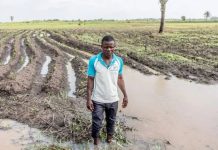
By Kofi Adu Domfeh
Tens of families and households were displaced in just two hours of rainstorms in parts of Ghana, as the storm devastated their homes.
Affected residents of Jachie in the Ashanti region have had to seek shelter with friends and relatives spared by the weather disaster in May 2024.
And the consequences of their predicament are telling – loss of property, dejection, homelessness, shattered livelihoods.
In a discomforting appeal, the local assembly member for the community pleads with people accommodating displaced residents to spare the young girls from unsolicited sex, which could lead to unwanted teenage pregnancies.
The man’s fear of sexual abuse of girls seeking shelter from neighbours tells of the widespread vulnerabilities of local communities to the adverse impact of extreme weather conditions.
Meanwhile, urban areas, especially Accra and Kumasi, are more profoundly flooded. In some instances, trees are uprooted, as some fall on vehicles and destroy power cables. These floods from the rains leave roads inundated, homes soaked, and people stranded. And sometimes, people die.
Scientists and weather officers have warned of more of such extreme weather incidents.
More than floods
In reality, the rains are coming after the intense heatwaves recorded in the past months, and there are more extremes.
The theme for this year’s World Environment Day, “Land restoration, desertification and drought resilience”, highlights the importance of restoring degraded lands and ecosystems, combating desertification and land degradation, and building resilience to droughts and other climate-related disasters.
This theme aims to raise awareness about the critical role healthy lands play in supporting biodiversity, mitigating climate change, and ensuring human well-being.
It encourages individuals, governments, and organizations to take action to restore and protect the world’s lands, forests, and natural resources.
Going beyond Green Ghana
Working towards a sustainable and resilient future calls for intentional resilience building.
The Green Ghana Day initiative is therefore laudable as an environmental stewardship and collective responsibility to plant millions of tree seedlings across the country every year.
The collective responsibility of individuals, communities, corporate entities, and government institutions to plant and nurture planted trees to maturity needs to be sustained as a mitigation drive to combat the escalating climate crisis.
But while this environmental conservation activity is commendable, Ghana’s resilience building and promotion would need more concerted effort.
The Environmental Protection Agency (EPA) has already initiated a project of engaging local assemblies to integrate climate change adaptation strategies into their development plans.
Upgrading the climate consciousness of the assemblies is an important step towards addressing the increasing vulnerability of communities to climate change impacts.
These communities are faced with the realities of severe temperatures that could wreak havoc on food production, infrastructure development, health promotion and general livelihoods.
Activities at the local level remain critical for vulnerable communities to cope with the realities of climate change while exploring opportunities to build resilience.
It has become imperative to look at:
- – Reforestation and afforestation efforts
- – Soil conservation and sustainable agriculture practices
- – Wetland restoration and conservation
- – Combating land degradation and desertification
- – Promoting sustainable land use and management practices
- – Infrastructure resilience building
By addressing these issues, communities can work towards a more sustainable and resilient future for all.
Kofi Adu Domfeh is a journalist and Climate Reality Leader



















